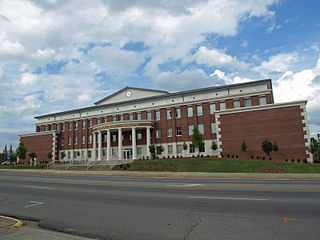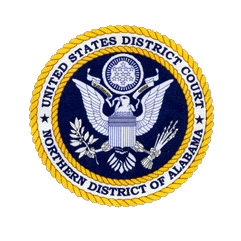Wallace | |
|---|---|
| Coordinates: 31°12′35″N87°13′06″W / 31.20972°N 87.21833°W |
Wallace is an unincorporated community in Escambia County in the U.S. state of Alabama. [1] [2]
Wallace | |
|---|---|
| Coordinates: 31°12′35″N87°13′06″W / 31.20972°N 87.21833°W |
Wallace is an unincorporated community in Escambia County in the U.S. state of Alabama. [1] [2]

Cullman County is a county located in the north central portion of the U.S. state of Alabama. As of the 2020 census, the population was 87,866. Its county seat and largest city is Cullman. Its name is in honor of Colonel John G. Cullmann.

George Corley Wallace Jr. was the 45th governor of Alabama, serving from 1963 to 1967, again from 1971 to 1979, and finally from 1983 to 1987. He is remembered for his staunch segregationist and populist views, however, in the late 1970s, Wallace moderated his views on race, renouncing his support for segregation. During Wallace's tenure as governor of Alabama, he promoted "industrial development, low taxes, and trade schools." Wallace unsuccessfully sought the United States presidency as a Democratic Party candidate three times, and once as an American Independent Party candidate, carrying five states in the 1968 election. Wallace opposed desegregation and supported the policies of "Jim Crow" during the Civil Rights Movement, declaring in his very controversial 1963 inaugural address that he stood for "segregation now, segregation tomorrow, segregation forever".

Lurleen Burns Wallace was an American politician who served as the 46th governor of Alabama for 16 months from January 16, 1967, until her death on May 7, 1968. She was the first wife of Alabama governor George Wallace, whom she succeeded as governor because at the time the Alabama constitution forbade consecutive terms.

James Browning Allen was an American Democratic politician serving as U.S. senator representing Alabama. Allen previously served as the Lieutenant Governor of Alabama and also served in the Alabama Senate and the Alabama House of Representatives.

Maryon Allen was an American journalist who served as United States Senator from Alabama for five months in 1978, after her husband, Senator James B. Allen, died in office. She held no public office prior to her appointment to her husband's old senate seat. She was appointed by Democratic Alabama Governor George Wallace.

The United States District Court for the Northern District of Alabama is a federal court in the Eleventh Circuit.

Frank Minis Johnson Jr. was a United States district judge and United States circuit judge serving 1955 to 1999 on the United States District Court for the Middle District of Alabama, United States Court of Appeals for the Fifth Circuit and United States Court of Appeals for the Eleventh Circuit. He made landmark civil rights rulings that helped end segregation and disenfranchisement of African Americans in the South. In the words of journalist and historian Bill Moyers, Judge Johnson "altered forever the face of the South."

Vivian Juanita Malone Jones was one of the first two black students to enroll at the University of Alabama in 1963, and in 1965 became the university's first black graduate. She was made famous when George Wallace, the Governor of Alabama, attempted to block her and James Hood from enrolling at the all-white university.
The Election Massacre of 1874, or Coup of 1874, took place on election day, November 3, 1874, near Eufaula, Alabama in Barbour County. Freedmen comprised a majority of the population and had been electing Republican candidates to office. Members of an Alabama chapter of the White League, a paramilitary group supporting the Democratic Party's drive to regain political power in the county and state, used firearms to ambush black Republicans at the polls.

The 1996 United States Senate election in Alabama was held on November 5, 1996. Incumbent Democratic U.S. Senator Howell Heflin decided to retire. Republican Jeff Sessions won the open seat, becoming the first of his party to win this seat since Reconstruction in 1868 and only the second Republican ever to be popularly elected to the U.S. Senate from Alabama.

The 1964 United States presidential election in Alabama was held on November 3, 1964. Alabama voters chose ten representatives, or electors, to the Electoral College, who voted for President and Vice-president. In Alabama, voters voted for electors individually instead of as a slate, as in the other states.

Following his election as governor of Alabama, George Wallace delivered an inaugural address on January 14, 1963 at the state capitol in Montgomery. At this time in his career, Wallace was an ardent segregationist, and as governor he challenged the attempts of the federal government to enforce laws prohibiting racial segregation in Alabama's public schools and other institutions. The speech is most infamous for the phrase "segregation now, segregation tomorrow, segregation forever", which became a rallying cry for those opposed to integration and the civil rights movement.

The Stand in the Schoolhouse Door took place at Foster Auditorium at the University of Alabama on June 11, 1963. In a symbolic attempt to keep his inaugural promise of "segregation now, segregation tomorrow, segregation forever" and stop the desegregation of schools, George Wallace, the Democratic Governor of Alabama, stood at the door of the auditorium as if to block the way of the two African American students attempting to enter: Vivian Malone and James Hood.
Crisis: Behind a Presidential Commitment is a 1963 direct cinema documentary film directed by Robert Drew. The film centers on the University of Alabama's "Stand in the Schoolhouse Door" integration crisis of June 1963. Drew and the other filmmakers, including D. A. Pennebaker and Richard Leacock, were given expanded access to key areas, including United States President John F. Kennedy's Oval Office and the homes of United States Attorney General Robert F. Kennedy and Governor George Wallace of Alabama. The film first aired on the American Broadcasting Company (ABC) as an installment of Close-Up! four months after the incident, on October 28, 1963. It was added to the National Film Registry of the Library of Congress on December 28, 2011.

The 1968 United States presidential election in Alabama was held on November 5, 1968. In Alabama, voters voted for electors individually instead of as a slate, as in the other 49 states.

The 1966 Alabama gubernatorial election took place on November 8, 1966, and resulted in the election of Lurleen Wallace as the governor over U.S. Representative James D. Martin. Incumbent Democrat George Wallace was term limited and could not seek a second consecutive term; he later successfully ran again in 1970 and 1974 before being term-limited again, and then successfully ran again in 1982.

The 1968 United States presidential election in South Carolina took place on November 5, 1968. All 50 states and the District of Columbia were part of the 1968 United States presidential election. South Carolina voters chose 8 electors to the Electoral College, who voted for president and vice president.

The 1948 United States presidential election in Alabama was held on November 2, 1948. Alabama voters sent eleven electors to the Electoral College who voted for President and Vice-President. In Alabama, voters voted for electors individually instead of as a slate.

The 1968 United States presidential election in Louisiana was held on November 5, 1968, as part of the 1968 United States presidential election. Along with four other contiguous southern states, former and future Alabama Governor George Wallace won the state for the American Party by a large margin against Democrat Hubert Humphrey and Republican Richard Nixon. As of the 2024 presidential election, this is the last election in which Jefferson Parish, St. Tammany Parish, Lafayette Parish, Ouachita Parish, Bossier Parish, Union Parish, and LaSalle Parish did not vote for the Republican presidential candidate.